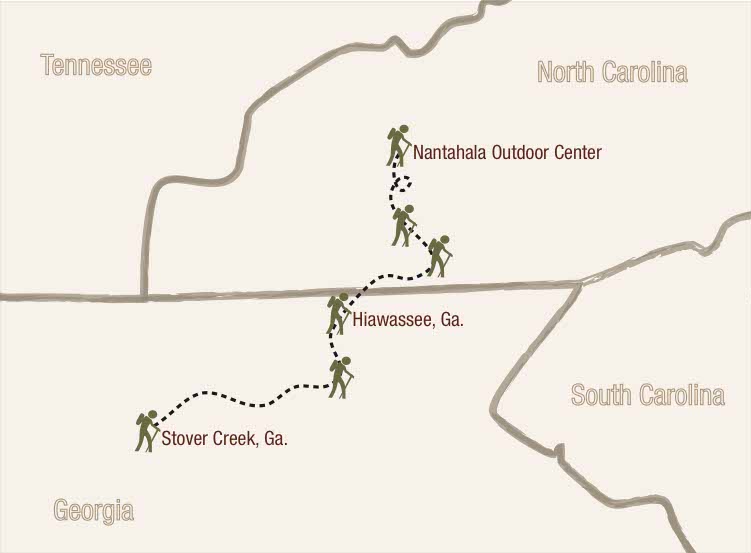Most seniors are trying to pass their classes, enjoy their last semester of college and just get by until graduation, but not William Wells. He is spending his final semester as a student at The University of Alabama away from campus, classes and friends.
Friday, he stood outside of an Ingles grocery store in Hiawassee, Ga. He hitched a ride into town from the Blueberry Patch Hostel, where he stayed that night. Just a couple of nights before, he was staying in a three-walled, square shelter in Stover Creek, Ga., with several mice for roommates. In a few days, Wells should reach the Nantahala Outdoor Center in North Carolina.
Linking each of Wells’ stops is the Appalachian Trail, commonly referred to as the AT. The AT, roughly 2,180 miles in length, is one of the longest continuously marked footpaths in the world. The trail passes through 14 states along the crests and valleys of the Appalachian mountain range from the southern end at Springer Mountain, Ga., to the northern end at Katahdin, Maine. It is estimated that 2-3 million people visit the trail each year, and about 1,800 to 2,000 people attempt to “thru-hike” the trail.
Wells will be one of the thousands attempting to thru-hike the AT, and he will spend his final semester as a student at the University doing it.
“It’s pretty cool because I am a full-time student at Alabama, but I am actually not going to any classes,” Wells said.
(See also “UA arboretum untapped resource“)
Instead of sitting in a classroom, Wells will be outdoors taking in the sites of the Appalachian Mountains. Instead of spending his time with teachers and students this semester, he will be surrounded by other hikers and learning from them.
Wells’ depth study is wildlife and land management through New College. He was able to save all of his independent study hours for this trip. His hours come from the time he spent creating a detailed plan for the trip, more than 40 pages long, and for the actual hike itself, which he is estimating will take him about four months.
“I have always enjoyed the outdoors, from backpacking to climbing to caving,” Wells said. “My passion for the outdoors landed me a job as a trip leader for the University’s Outdoor Recreation Center. Thru-hiking the Appalachian Trail has been a dream of mine for years.”
This dream did not start to take form until the spring semester of Wells’ sophomore year. That semester, he took a creativity class where his final project was a short planning paper on thru-hiking the Appalachian Trail.
At the beginning of his junior year, Wells began talking with his advisor and creativity teacher, John Miller. Miller helped Wells turn his final project for his creativity class into credit for independent study hours.
“William took my creativity seminar a couple of years ago and was struggling to come up with a final project for the class,” Miller said. “So, I suggested that he combine his enthusiasm for outdoor leadership with creativity and create a trip plan for a hypothetical trip to important natural attractions around the world. He did a great job with the project, so when he came to me to discuss a real-world version for hiking the AT, I knew he would bring his skills to the project.”
In 2013, Wells started this process working with professor Mike Steinberg, Wells’ advisor in New College, Miller said. Steinberg is a geographer who has done fieldwork in sites ranging from Belize to Iceland.
“Steinberg’s contribution should be highlighted more than mine,” Miller said. “All I did was to help William structure the work-product associated with the project when professor Steinberg left on his sabbatical. I love the outdoors, but not like William and professor Steinberg do. At the end of the day, I want a roof over my head and a bed to sleep in.”
Miller said hiking the AT is a fun adventure, but it is by no means an easy one.
“It’s one thing to plan a day or weekend trip,” Miller said. “A thru-hike of the AT is both a physical and a mental challenge. Even planning for it makes someone consider what their strengths and weaknesses are. [It] forces them to consider what the difference is between the way they want to think of themselves and the reality of who they are. In many ways, that’s the point of experiential learning, to give students the opportunity to personalize, to internalize the lessons of their education in hands-on or applied contexts.”
Wells is already experiencing pain and soreness, and he is just more than 70 miles into the trip. Carrying about 28 pounds and hiking up and down the Appalachian Mountains takes a toll on the body.
“A lot of people believe hiking up mountains is the hardest part,” Wells said. “They are definitely wrong. Really, it’s going down that is the hardest part. My muscles have tightened up a lot, and my joints are sore from all the pressure.”
(See also “Travel writer ‘jet hikes’ her way across country“)
When Wells gets to rest for the night, he is usually staying in shelters or hostels along the trail. The shelters are usually three wooden walls with an open front and a wood or tin roof. Wells said the hikers are not the only creatures staying there, though.
“The first night I went to sleep and realized there was a nest of mice in the shelter,” Wells said. “I could feel them running over my sleeping bag all night.”
Many of the hikers have made a game out of killing mice in the shelters.
“There are tally marks on the walls that hikers have made whenever they kill a mouse,” Wells said.
Despite the difficulties involved the experience, he said he has enjoyed meeting new people on the trail.
“The best part so far has definitely been the people,” Wells said. “Everyone I have met has been awesome. There were a couple girls from Maryville and a couple of ex-Marines. There have also been a lot of weekend backpackers. I hiked for a while today with a guy known on the trail as Tumbleweed.”
Wells said he hikes much of the day by himself. Sometimes he catches up to some people and hikes with them for a while or camps with other backpackers.
Wells said the long four months will be well worth it when he comes to the end of the trail in Maine in July.
“Personally, I hope that William can deepen his appreciation for the natural world and think about whether the kinds of things that tend to occupy a lot of mental and emotional space in day-to-day living merit the attention that we give them culturally,” Miller said. “William has mentioned that he wants to better understand who he is and what he wants from life, and I think this will give him the tools to do that and more.”
From an academic perspective, Miller said he hopes that the experience of hiking the AT will also serve to underscore the importance of Wells’ preparation and his training.
“Managing a process as complex as this and thinking through various eventualities in a clear-headed way is both an educational and character-building experience,” Wells said.
Wells said he hopes this experience will turn into a career path for him in the future.
“I love backpacking,” Wells said. “I will get so much more experience from this trip, and it’s a good chance to trust my knowledge of being outdoors. It will be great to come away with an even greater trust in my skills, and hopefully I will eventually be able to work in the backcountry someday.”
Steinberg said hiking the Appalachian Trail is much like a microcosm of the real world. This is Steinberg’s third student to hike the AT.
“The AT thru-hike is more than a hike, and it prepares you for more than just a physical experience,” Steinberg said. “The AT requires a great deal of planning, a great deal of resilience and the ability to set goals. In the context of the AT, these are all critically important because they could be the difference between running out of food and water far from a town or sleeping in the rain instead of a shelter, or even a failed trip altogether. Beyond the AT, these sort of exercises are important because there isn’t a career out there that doesn’t require you to make good planning decisions, be resilient and set goals.”
To follow Wells’ trip, visit his blog, travelerbytrail.com.
(See also “Hikes merge nature, literature“)









